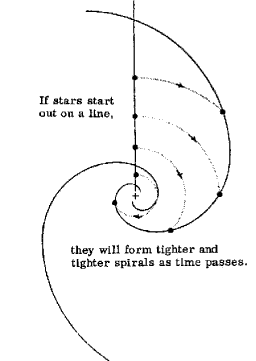 |
Science Frontiers ONLINE No. 55: Jan-Feb 1988 |
|
|
Why do spiral galaxies stay that way? or do they?
Sometimes the simplest of observations produces the stickiest of dilemmas. Take, for instance, a well-formed spiral galaxy, of which there are a great many. When astronomers measure the circumferential velocities of the stars, as they circle around the galaxy's hub, they find that all the stars orbit at about the same velocity, regardless of how far out from the hub they are. Their speeds do not drop off with increasing distance, as the velocities of the planets do in the solar system. This observation is anomalous itself, because it seems that the laws of orbital motion have been violated. We will save this anomaly for another day, the one we are after now is called: The Winding Dilemma. N. Comins and L. Marschall elaborate as follows:
"Stars closer to the center of a spiral galaxy don't have as far to go to complete an orbit as stars located farther from the center. Thus, inner stars should orbit more frequently than outer stars, resulting in a spiral that gradually winds up as the galaxy ages. But observations of spiral galaxies at various distances -- and thus at different stages in their evolution -- have shown that this is not the case. Astronomers believe density waves, stochastic star formation, or perhaps a combination of both processes may sustain or regenerate the spiral pattern."
Density waves have recently been applied to explain the spiral rings of Saturn, and now to the arms of spiral galaxies. The density waves are thought to stimulate the condensation of bright new stars as they move through space. A good analogy is the bioluminescent wake of ship in tropical waters. The density waves in a galaxy maintain the spiral pattern with new stars, while the old stars die out (in much less time than it takes for them to orbit the hub) as they orbit out of the spiral pattern.
Postulating density waves just raises more questions, as is often the case in science. What causes the density waves? Theory says that the density waves should damp out in under a billion years, yet we see spiral galaxies over a wide range of ages.
(Comins, Neil, and Marscall, Laurence; "How Do Spiral Galaxies Spiral?" Astronomy, 15:7, December 1987.)
Comment. The scientifically outrageous resolution of the winding dilemma is to assert that the universe is so young that the spiral patterns have not yet been dispersed. Interestingly enough, Saturn's rings may turn out to be very young, too!
Reference. The anomalous rotation of matter in galaxies is covered in more detail in AWB5 in our catalog: Stars, Galaxies, Cosmos. For further information on this book, visit: here.
